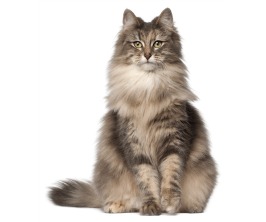
History
The Norwegian Forest Cat originated as a wild cat in the forests of Norway. For centuries, the skogcatt—a Norwegian word that translates as “forest cat”—survived by his wits or offered his services as a mouser to farmers and housewives in exchange for shelter in barns, stables or homes. In 1938, the cats were exhibited at a show in Oslo, but World War II interrupted any plans for developing them as a breed. Fortunately, they survived the war, just barely, but there were still some hard decades ahead and little was done with them until the 1970s.
Description
The head has an inverted triangle shape, pointed at the chin and then widening on each side up toward the medium to large ears, which are heavily tufted. Large, almond-shaped eyes are green, gold or copper, although white cats may have blue eyes or odd eyes (one blue eye and one eye of another color). The moderately long body looks powerful, with its broad chest and heavily muscled thighs. Large round paws have tufts of fur between the toes. The bushy tail is as long as the body.
Grooming and Physical Needs
Size: Big cats. Males can weigh 13 to 22 pounds or more. The Wegie matures slowly and isn’t full grown until 5 years of age.
- Grooming Needs: Brush or comb the Norwegian Forest Cat’s long coat once or twice a week, using a bristle brush, wire slicker brush or stainless steel comb.
- Coat Type: long, thick, beautiful coat and large size
- Moulting: High
- Exercise Needs: this large and athletic cat is a climber. You will often find him at the highest point he can reach in the home
- Average Life Span: 14-16 years
- Healthcare:
Behaviour
- Family: This is a smart, independent cat who learns quickly and has an alert nature. He likes to play and thrives with a busy family that loves him
- Temperament: Even with family, he’s not much of a lap cat, but a nice scratch between the ears or beneath the chin is always welcome, and he’ll usually reciprocate with a nice head butt or cheek rub
- Trainability:
- Sociability (Other Pets): perfect choice for families with children and cat-friendly dogs
- Meowing: Quiet voice is employed only when he needs something
